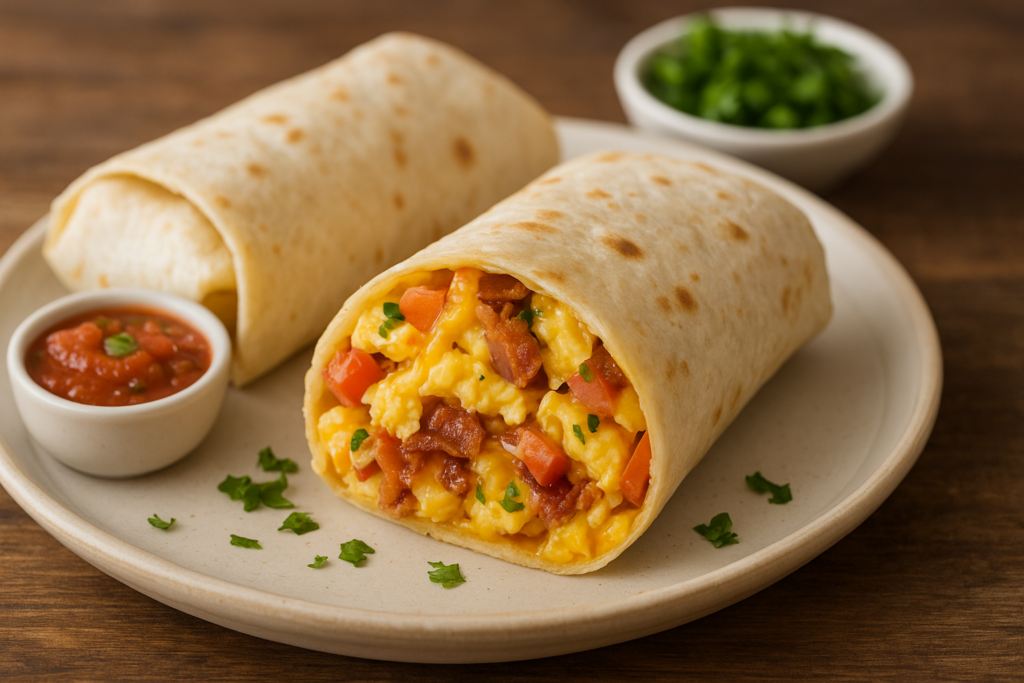8, Oct 2025
How to Make Breakfast Burritos

Over years of cooking for myself and others I learned that small systems beat big intentions every time. I don’t mean the mystical kind of system—just simple choices that repeat. how to make breakfast burritos is one of those choices: a reliable little ritual that turns scattered mornings into calm, delicious momentum. I’ll show you the techniques I always come back to, the swaps that actually work, and the make-ahead steps that save me from skipping breakfast.
Choosing the right tortilla and why it matters
Tortillas are the backbone of any breakfast burrito. I prefer a large, pliable flour tortilla because it folds cleanly and holds hot fillings without tearing. Corn tortillas taste great, yet they’re smaller and break more easily when packed with eggs and salsa.
Thickness affects both texture and warmth retention. Thicker tortillas resist sogginess and give you a satisfying chew, while ultra-thin ones crisp quickly but risk falling apart. I often choose an 8–10 inch flour tortilla for balance.
If you want extra points, lightly warm the tortilla on a dry skillet for 10–20 seconds per side. That simple step boosts flexibility, flavor, and the final mouthfeel of the burrito. Pro tip: keep tortillas wrapped in a clean towel while you assemble to retain heat and softness.
Essential ingredients that make your breakfast burrito sing
Start with a strong foundation: soft scrambled eggs, a melting cheese, a cooked protein, and a bright element like salsa or pickled jalapeños. Each plays a role: eggs add creaminess, cheese binds flavors, protein makes it filling, and an acidic or spicy component keeps it lively.
I always keep small bowls of chopped tomatoes, cilantro, and sliced avocado nearby. They’re optional but they lift the burrito from “good” to “memorable.” Salt and pepper deserve respect—season eggs generously so the whole bite tastes balanced.
Texture contrast matters too. Add something crisp—tortilla chips, quick-pickled onions, or roasted peppers—to prevent a one-note, mushy bite. A layered approach to textures and temperatures creates a burrito that reads interesting on every forkful.
The simple egg techniques every home cook should know
For reliable eggs I use a low-and-slow scramble method. Crack eggs, whisk until a bit frothy, then cook over medium-low with a pat of butter. Stir gently and remove while slightly underdone; carryover heat finishes them. This yields tender curds rather than rubbery blocks.
If you’re short on time, whisk eggs with a splash of milk or water and cook over medium-high while stirring constantly—this speeds things but still produces fluffy eggs. I rarely use premade egg products because fresh eggs taste cleaner and fold better into the tortilla.
For a creamier texture, stir in a spoonful of cream cheese or grated cheddar at the end. That binds everything and helps the burrito hold together when cooled. Tip: add eggs last when assembling to keep other fillings from leaking moisture into them.
Flavor boosters: cheeses, sauces, and herbs that transform
Cheese is a mood-maker. I often use Monterey Jack for its meltability or sharp cheddar for a more pronounced tang. Queso fresco is great crumbled on top after cooking for a salty, fresh bite. Layering two cheeses—one melty and one flavorful—works beautifully.
Sauces are where you can be playful. Salsa verde, chipotle mayo, hot sauce, or a drizzle of cilantro-lime crema make every bite pop. I keep a squeeze bottle of lime crema in the fridge for quick assembly and consistent distribution across burritos.
Fresh herbs change everything with very little effort. Chopped cilantro or green onion sprinkled just before folding brightens heavy ingredients. I avoid overloading herbs during cooking; add them at the end to preserve freshness and color.
Protein options: beyond bacon and sausage
Traditional proteins are great, yet there are plenty of better-for-you, flavorful alternatives. Shredded rotisserie chicken tossed in salsa verde, spiced ground turkey, or smoked salmon offer different textures and nutrients. I often use leftover roast chicken for speed and taste.
For quick vegetarian protein, pan-fried tempeh crumbles or seasoned black beans do the trick. I season beans with cumin, smoked paprika, and a little lime to mimic the savoriness of meat. Lentils also make a surprisingly robust filling when cooked until tender and warmed with spices.
If you want indulgence with balance, use thinly sliced chorizo or turkey bacon—cook them until crisp, then drain on paper towels. Crispy edges add crunch and a hit of fat that carries flavor through the bite.
Vegetarian and vegan swaps that don’t feel like compromises
For vegetarian swaps, roasted sweet potatoes are a personal favorite; they add natural sweetness and a creamy texture that pairs well with black beans and avocado. I roast cubes until edges caramelize, then toss with a little chili powder for warmth.
Vegan eggs are getting better—crushed tofu scrambled with turmeric, nutritional yeast, and kala namak offers an eggy texture and sulfurous aroma similar to eggs. Tempeh bacon or smoked tofu supplies the savory, smoky element we often miss.
Don’t skip fat. Vegan burritos still need richness, so include mashed avocado, olive oil-dressed veggies, or a nut-based crema. Those layers of fat deliver mouthfeel and satiety that make plant-forward burritos feel complete.
Folding and rolling: keep everything inside every time
Master the fold and you’ll avoid mess and mid-bite spills. Lay the tortilla flat, place fillings in a tight horizontal line slightly off-center, fold the short sides in first, then fold up the bottom and roll away from you. This creates a sealed pocket that won’t unravel.
I often warm the tortilla a final time after folding in a skillet seam-side down for 30–45 seconds. That seals the seam and crisps the outside lightly, creating a pleasant contrast to the soft interior. Use a weight or press if you want an almost-panini texture.
If you’re packing burritos for later, wrap each in foil while warm, then refrigerate. The foil keeps the shape and prevents moisture from seeping in. For extra insurance, line the tortilla with a thin smear of cheese or sauce before adding watery fillings to create a moisture barrier.
Make-ahead and freezer methods for rushed mornings
I batch-make burritos at the start of the week. Assemble fully, wrap tightly in foil, and freeze flat on a tray. Once solid, stack them in freezer bags so they take up minimal space. Frozen burritos are lifesavers on workdays or busy weekends.
Use slightly undercooked eggs and cooled proteins to reduce condensation before freezing. I aim for fillings that are warm but not steaming when wrapped. That prevents ice crystals and preserves texture during freezing and reheating.
Label each foil with the date and flavor. Most frozen burritos keep well for up to three months. Rotate older ones forward and plan to eat the earliest batch first. Trust me—this simple system keeps mornings calm and breakfasts consistent.
Reheating tips to keep texture and flavor intact
Microwaving works for speed but can make tortillas chewy. If using a microwave, remove foil and wrap the burrito in a damp paper towel; heat in 60–90 second bursts until warm. Finish with a quick sear in a hot skillet for a crisp exterior if you have time.
Oven reheating is my preferred method for frozen burritos. Keep them wrapped in foil and heat at 375°F (190°C) for 20–25 minutes from frozen, or 12–15 minutes from thawed. The foil traps steam and warms evenly without drying the filling.
To revive a soggy tortilla, a hot pan or grill press will restore texture. Place seam-side down first to seal and then rotate to crisp each side. A final squeeze of fresh lime or a drizzle of crema brightens flavors after reheating.
Creative serving ideas and pairing suggestions
Turn a simple burrito into a meal by pairing it with fresh sides: a quick slaw, citrusy pico de gallo, or a peppery arugula salad. These add freshness and balance the richness of eggs and cheese. I often toss arugula with lemon and a pinch of salt for a simple side.
For a brunch spread, offer a toppings bar—salsas, pickled onions, sliced radish, and hot sauces. People love customizing, and it’s an easy way to entertain with minimal effort. I set out small bowls and let guests build their own creations.
Want to make it portable? Wrap a burrito in parchment, then foil, and serve with a small container of sauce for dipping. It’s commuter-friendly and keeps things tidy. I bring a stack of these for road trips and long mornings when eating on the go is non-negotiable.
Conclusion
Learning how to make breakfast burritos the right way gives you dependable, delicious mornings. Focus on a flexible tortilla, well-seasoned eggs, smart protein choices, and a few flavor boosters. Make-ahead and reheating techniques turn this from a nice idea into a weekly habit that actually sticks.
If you enjoyed these tips, try one new trick each week—warm tortillas, a new protein, or a sauce—and notice how much easier mornings become. Small experiments lead to big mornings.
Call to action: If you make a batch, leave a comment below telling me your favorite filling or share a photo on social and tag the recipe. I love seeing creative twists!
FAQ
How long do homemade breakfast burritos last in the fridge?
Store wrapped burritos in the refrigerator for up to 4 days. If they contain fresh avocado, expect the quality to drop sooner; consider adding avocado after reheating. Always reheat to steaming hot before eating.
Can I freeze breakfast burritos, and for how long?
Yes—wrap burritos tightly in foil and freeze for up to 3 months. Thaw in the fridge overnight when possible. From frozen, bake at 375°F (190°C) for about 20–25 minutes until heated through.
What’s the best way to keep tortillas from getting soggy?
Prevent sogginess by layering cheese or a smear of sauce directly on the warm tortilla first; it creates a moisture barrier. Use warm, not steaming, fillings and wrap burritos tightly to minimize condensation.
Are there low-carb or gluten-free options?
Yes—use low-carb or gluten-free tortillas, or swap for a large collard green leaf or lettuce wrap for a very low-carb option. Keep fillings the same, but press gently to avoid tearing thin greens.
How do I make a breakfast burrito that travels well?
Wrap burritos in parchment then foil while still warm, and keep sauces separate in small containers. For long trips, pack in an insulated bag. Choose sturdier fillings like roasted veggies and beans to prevent leaks.
Recipe notes: These tips are flexible—use what you have and make small swaps as needed. Happy rolling!
- 0
- By Pankajatray
- October 8, 2025 08:12 AM

